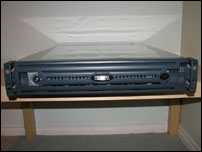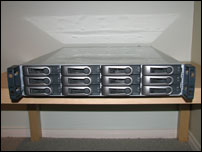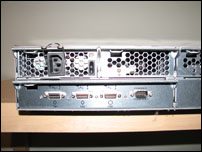Promise VTrak J300s
by Jason Clark & Dave Muysson on February 2, 2007 8:00 AM EST- Posted in
- IT Computing
The Promise VTrak J300s
Promise has long been known for their involvement in the storage industry. If you can remember back to the early nineties (Ed: sorry if that makes some of you feel old...), Promise was making VESA EIDE accelerator cards. Maybe unknown to some are their VTrak products targeted at the small to enterprise storage consumer. They have iSCSI SAN solutions and a range of Direct Attached solutions like the VTrak J300s that we're evaluating in this article.
The VTrak J300s is a 2U 12 drive RAID/JBOD solution capable of housing either SAS or SATA drives. It has the ability to daisy chain up to three additional chassis off the expansion port on the rear of the device. This would give you a total capacity of 24 TB when using 500GB SATA drives.
Each chassis has three 3 Gbit SAS 4x ports, two host ports and one expansion port for cascading the chassis together. If you're wondering what 4x ports are, it is another way to describe a wide port. As we discussed earlier in the article a wide port is made up over several links, in this case 4 links each with 3Gbit of bandwidth, which means that the 4x (wide port) is capable of 12 Gbit/sec of overall bandwidth.
Users can purchase an additional I/O module for redundancy, which also has three 3 Gbit 4x ports. Promise took reliability quite seriously with this unit; with redundant I/O, power, cooling, and monitoring there is no single point of failure. At the rear of the unit there is also a serial port that allows the administrator to use the Command Line Interface (CLI) and monitor the device remotely.
Management of the J300s was fairly simple and straightforward. The chassis and drives were identified by the RAID controller without any issue, including the Windows driver for the chassis. The CLI gives you access to a number of things such as fan speeds, voltages, temperature, SAS addresses, phy status, error counters, etc. It also lists vital product data for field replaceable units, current firmware version, uptime, and thermal management control. We found the CLI to be easy to navigate, and complete documentation is provided on its use.
Promise has long been known for their involvement in the storage industry. If you can remember back to the early nineties (Ed: sorry if that makes some of you feel old...), Promise was making VESA EIDE accelerator cards. Maybe unknown to some are their VTrak products targeted at the small to enterprise storage consumer. They have iSCSI SAN solutions and a range of Direct Attached solutions like the VTrak J300s that we're evaluating in this article.
 |
 |
| Click to enlarge | |
The VTrak J300s is a 2U 12 drive RAID/JBOD solution capable of housing either SAS or SATA drives. It has the ability to daisy chain up to three additional chassis off the expansion port on the rear of the device. This would give you a total capacity of 24 TB when using 500GB SATA drives.
 |
 |
| Click to enlarge | |
Each chassis has three 3 Gbit SAS 4x ports, two host ports and one expansion port for cascading the chassis together. If you're wondering what 4x ports are, it is another way to describe a wide port. As we discussed earlier in the article a wide port is made up over several links, in this case 4 links each with 3Gbit of bandwidth, which means that the 4x (wide port) is capable of 12 Gbit/sec of overall bandwidth.
Users can purchase an additional I/O module for redundancy, which also has three 3 Gbit 4x ports. Promise took reliability quite seriously with this unit; with redundant I/O, power, cooling, and monitoring there is no single point of failure. At the rear of the unit there is also a serial port that allows the administrator to use the Command Line Interface (CLI) and monitor the device remotely.
Management of the J300s was fairly simple and straightforward. The chassis and drives were identified by the RAID controller without any issue, including the Windows driver for the chassis. The CLI gives you access to a number of things such as fan speeds, voltages, temperature, SAS addresses, phy status, error counters, etc. It also lists vital product data for field replaceable units, current firmware version, uptime, and thermal management control. We found the CLI to be easy to navigate, and complete documentation is provided on its use.










31 Comments
View All Comments
JarredWalton - Monday, February 5, 2007 - link
"or seek times" = "where seek times"yyrkoon - Saturday, February 3, 2007 - link
many 'old timers' are going to claim SCSI is better than anything, because its been around a long time, and has a proven track record. What these 'old timers' don't realize, is that SAS, and SCSI drives, share the same ancestry, except that SAS, also shares a history with SATA. *shrug*mino - Sunday, February 4, 2007 - link
Yes they are those.However most posters here do NOT dispute the benefits and superiority os SAS over U320.
The point is that according the numbers published even SATA 7.2k is on par with SCSI320 10k !!!
Those numbers simply coudn't be much more away from the reality then they are.
Artificially more than halving the performance of a tested platform simply is not acceptable.
Also to make tables in the sense SATAI vs. SATAII vs. SCSI vs. SAS is on itself seriously misleading to the extent that best thing to do for AT (provided they were not paid for it!) would be to call in the article eithe indefinitelly or for rewrite.
Actually the reality is:
SATA I or SATA II driver do not exist, there are only SATA drives inn existence as of now.
performance-wise on single to 6-drives/system:
SATA(7.2k) < SATA(10k) < SCSI(10k) = SAS(10k) < SCSI(15k) = SAS(15k)
on 8+drives system:
SATA(7.2k) < SATA(10k) < SCSI(10k) < SAS(10k) < SCSI(15k) < SAS(15k)
For an 12-drive test the results should be:
SATA(7k) << SCSI(10k) << SAS(15k) which is obvious even before any testing.
However much more beneficial test would be:
SATA(10k-Raptor) vs. SCSI(10k) vs. SAS (10k) with SCSI and SAS driver ideally from the same line.
mino - Sunday, February 4, 2007 - link
"SATA I or SATA II driver" --> "SATA I or SATA II drives"mino - Saturday, February 3, 2007 - link
Yes, one sometimes has to make compromises.But benchmarking SCSI setup with 12drives on a SINGLE cable is plain stupid and tabloid-like aproach.
This organization seriously criples perfromance and is NEVER used unless there is some very serious reason for it.
mino - Saturday, February 3, 2007 - link
If you did have no SCSI option than the one you used, you should not have published those "SCSI" numbers at all. Those numbers as they are have nothing to do with SCSI being poor, they are simply showcasing that 3yrs 10k drive are slower than new 15k drives. Nothing new here.Googer - Friday, February 2, 2007 - link
That chart is missing the old 5.25 inch drives. The most famous of those was probably the Quantum Bigfoot. Quantum was bought out by Maxtor.http://images.anandtech.com/reviews/it/2007/promis...">http://images.anandtech.com/reviews/it/.../promise...
http://www.pcguide.com/ref/hdd/op/formIn525-c.html">http://www.pcguide.com/ref/hdd/op/formIn525-c.html
Justin Case - Friday, February 2, 2007 - link
Maybe the article author should read this...http://www.sata-io.org/namingguidelines.asp">http://www.sata-io.org/namingguidelines.asp
monsoon - Friday, February 2, 2007 - link
Hello,I'm used to change computers frequently, I have lots of data to store.
Currently I've got 4 external 300Gb drives and 4 external 400Gb drive; all of them connected through firewire.
I've been looking eagerly for solutions similar to the NORCO DS-1220; but I need to connect the storage unit to laptops as well, so it has to control RAID5 all by itself.
I can't find alternatives in the market, and while the UNRAID solution looks interesting, it's not safe, neither easy to implement.
Looking forward to external storage devices reviews for home users with big archives.
Units need to stand the test of time and be there while PCs come and go.
Ideally, I must be able to replace drives with higher capacity when they get cheaper, without having to replace all of them at the same time.
It better be silent; well, at least not loud...
Any idea ?
Thanks
mino - Saturday, February 3, 2007 - link
Look for some reliable NAS solution (+Gbit swith - now dirt cheap).